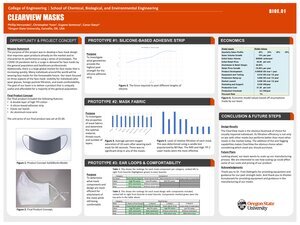
College of Engineering Unit:
Personal protective equipment is worn to minimize exposure to hazards that cause serious workplace injuries and illnesses. Face masks are generally worn to prevent the flow of foreign particles into the oral cavity and prevent illnesses that are transmitted through the air or in respiratory droplets. Due to the COVID-19 pandemic, the use of face masks has increased significantly; and so has the opportunity to develop a new face mask design that makes significant improvements to products currently on the market. The global face mask market is expected to reach 8.88 billion dollars by 2026 and is increasing at an annual rate of 4.8%. Despite the availability of COVID-19 vaccines in the United States, the use of face masks is still widespread and required in many settings. Additionally, there is a large global population that does not have equitable access to COVID-19 vaccines and will be using face masks in public for the foreseeable future. The use of face masks is also a necessary part of worker safety in the healthcare industry and other fields. To improve on current face mask designs, our team focused on three aspects of the face mask: visibility for individuals who wear glasses, foreign particle filtration, and mask comfortability. Currently, individuals who wear glasses have a difficult time using most face masks on the market because warm air exits the mouth and flows up through the gap between the skin and the top of the face mask. The warm air condenses on lenses and prevents visibility. At times, this presents a minor inconvenience. This can also present a potential hazard, such as for a surgeon operating on a patient or a laboratory employee working with dangerous chemicals. Furthermore, our team agreed that climate change is a global threat and it is important to impact the environment as little as possible in the production and use of face masks. Finally, the reason face masks are used is to prevent the flow of foreign particles into the oral cavity. According to the World Health Organization, there have been over 250 million confirmed COVID-19 cases and over five million deaths. This is just one of the many diseases that can be transmitted through the air or respiratory droplets.
In response to our customer needs, specifications were outlined to establish specific metrics that indicate if the product meets customer needs. Three technical models were developed to investigate key aspects of the masks. Based on these technical models, three prototypes were planned, designed, and tested. Prototype #1 focused on the silicon-based adhesive strip attached to the top of our mask to prevent air flow. Prototype #2 investigated mask fabrics, thread counts, and number of layers to determine the optimal combination that allowed for particle filtration and breathability. Prototype #3 included ear loop design and surveys that looked for customer input on our mask design. Our final product consisted of a double layer of high TPI cotton, a silicon-based adhesive strip, elastic ear bands, and an aluminum nose wire. Overall, the results of this project demonstrate that this mask has the potential to be a unique and popular product on the market.
Project Communication Piece(s):
| Attachment | Size |
|---|---|
| 479.59 KB |